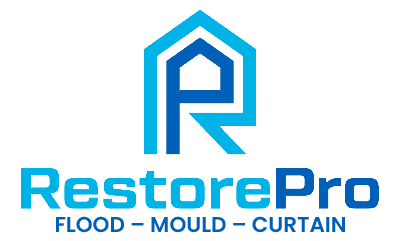When dealing with flood damage restoration, it is essential to document every detail meticulously for your insurance claim. Begin immediately by taking clear, extensive photos and videos of the damage to both your property and belongings.
You must compile a comprehensive list of all items affected, noting their condition before the flood. This evidence is crucial when dealing with your insurance adjuster.
Initial Steps After Flood Damage for Insurance Claims
After a flood, prioritise your safety by staying away from flooded areas until they’ve been declared safe by the authorities.
Before entering your home, inspect it for structural soundness. Look for visible cracks in the foundations or walls. It’s essential to ensure that utilities such as gas, water, and electricity aren’t only working but also safe to use. If you detect the smell of gas or notice frayed wires, contact professionals without delay.
Once you’re sure the building is stable, begin documenting the damage. Avoid discarding water-damaged items as your insurance company will require evidence. Take clear, detailed photographs of the affected areas and any damaged property. These images are vital when you file your insurance claim. Make a detailed list of what’s been damaged, noting the severity and type of damage for each item.
Navigating the Insurance Claims Process
After documenting the flood damage, it is important to effectively manage the insurance claims process. It’s essential to understand the conditions of your policy and how the claims procedure works. Make sure you know what flood damage your insurance covers, especially regarding the costs of preparing claims, which are often reimbursable. This coverage is crucial as it allows for professional help in calculating and maximising your settlement.
Consider hiring an independent claims consultant. They’re adept at accurately documenting and supporting claims, helping you achieve the best possible outcome. With severe weather causing not just property damage but also potential business interruptions, having an expert on your side can greatly benefit you.
Ensure that you communicate clearly and consistently with your insurer. Keep them informed with all the documentation of the damage and any correspondence related to your claim. Promptly submit evidence and maintain a log of all interactions to streamline the process and avoid any unnecessary delays.
Preparing for Your Insurance Claim
As you get ready to submit your flood damage insurance claim, it’s essential to collect all the required documents. Ensure you meet all policy conditions to prevent any issues during the claims process.
Required Flood Damage Documentation
Collect detailed documentation, including clear photos, videos, and lists of damages and costs. Begin by taking well-lit, clear photos and videos of all the areas in your home affected by the flood. Ensure each photo and video clearly shows the damage from various angles.
Write detailed notes and descriptions of the damage. Include the specific items damaged and the extent of harm to each. Accompany this with a list of all damaged items and their estimated value. If you have photos from before the damage or purchase receipts, these will be very helpful in supporting your claim.
Keep all receipts and invoices for repairs, replacements, and any additional costs due to the flood. These financial documents help to demonstrate the financial impact of the flood on you.
Policy Condition Compliance
Before you submit your flood damage insurance claim, ensure you have met all necessary conditions set by your insurer. This involves capturing all significant damage in a manner that meets your policy’s requirements. You should understand the specifics of what your insurance demands for documentation, which may include detailed descriptions, a list of damaged items, and perhaps video evidence.
Neglecting these requirements can lead to delays or even rejections of your claim. Review your policy carefully, possibly with professional assistance, to know exactly what’s expected of you.
Proving Insurance Claim Validity
After following the terms of your policy, concentrate on proving the validity of your claim by thoroughly documenting all the flood damage. It’s essential to take detailed photographs and comprehensive notes.
Begin by capturing images of the general area affected by the flood and then focus on individual damages. Ensure you also inspect and document less obvious places like basements or crawl spaces.
For each photograph, add a detailed note that includes the date, time, and a clear description of the damage. This method not only builds a timeline but also adds context that photos alone may not show.
If you have carried out any temporary repairs, make sure to document these as well. This demonstrates that you have taken steps to prevent further damage, which is a requirement in many policies.
Keep all receipts related to flood damage and repairs. These are crucial as they provide concrete proof of your expenses and are vital for the claims process. Organise these documents in chronological order in a folder or digital file to facilitate communication with your insurance provider.
Working With Brokers and Adjusters
Working with brokers and adjusters ensures that your flood damage claims are accurately submitted and fairly resolved. Brokers guide you through the complex insurance claims process, helping you to understand your policy details so you don’t overlook important aspects of your claim. They play a crucial role in explaining what your insurance covers, which greatly influences the success of your claim.
Loss adjusters, on the other hand, are essential in estimating your losses. They manage your claims and negotiate fair settlements with insurers. By agreeing with loss adjusters on key decisions, you can make the claims process more efficient, reducing the time taken and decreasing the likelihood of disputes. It’s vital that you communicate promptly with adjusters when issues occur. This proactive communication can prevent minor disagreements from becoming major problems and help expedite the resolution of your claim.
Additionally, involving loss adjusters when you encounter issues with suppliers or work schedules can help smooth out potential difficulties in the claims handling process. Their skills in problem-solving are invaluable in ensuring that your claim progresses smoothly towards resolution. Keep these interactions collaborative and focused to secure the best possible outcome for your claim.
Maximising Claims Outcome
To ensure you get the best possible outcome from your insurance claim, it’s essential to document every aspect of the flood damage meticulously. Begin by taking detailed photographs of all impacted areas and items from different angles to give a complete view. Make sure these photos are dated. These images are crucial when discussing your claim with the insurance company.
Next, make a comprehensive list of all damaged items. For each one, note its condition and estimate the cost to repair or replace it. This thorough record will help you demonstrate the full extent of the damage, ensuring that nothing is overlooked which could reduce the value of your claim.
Additionally, collect written estimates and advice from professionals on the necessary repairs and replacements. Providing these documents to your insurer increases the transparency of your claim. It proves that your cost estimates are supported by expert opinions, which helps to substantiate the amounts you’re claiming.
Insurance Claim Process Details
When you’re prepared to file your flood damage insurance claim, it’s vital to understand the necessary steps.
First, collect all the evidence you have, such as photographs, videos, and detailed descriptions of the damage. This information will back up your claim and assist in securing a fair assessment from the insurance company.
Steps for Submitting an Insurance Claim
Efficiently submitting your insurance claim requires careful preparation and organisation. Follow these steps to ensure a smooth process:
- Organise Your Documentation: Gather all photos, videos, and inventory lists of damaged items. Ensure descriptions and estimated values are included to support your claim. Collect all receipts and invoices related to repairs and replacements.
- Complete the Claim Forms: Fill out the forms provided by your insurance company. Be detailed and accurate when describing the extent of the flood damage. Attach all supporting documentation, including your detailed inventory, photos, videos, and receipts for incurred expenses.
- Submit Your Claim Promptly: Compile all the necessary documents. Submit your claim through your insurance company’s online portal, by email, or by post, according to their preferred method. Do this as soon as possible to avoid any delays in processing.
Tips for Collecting Evidence
Accurate evidence collection is crucial for supporting your flood damage insurance claim. Follow these tips for thorough documentation:
- Take Detailed Photos and Videos: Capture all affected areas and items from various angles. Include structural issues, visible signs of water damage, and the water’s height inside your home.
- Compile a Detailed List of Damaged Items: Include the value of items before the flood. Attach receipts, invoices, or purchase records if available to prove the value of your losses.
- Keep Repair Estimates and Quotes: Retain all documents from contractors that show the cost of restoring your property to its pre-flood condition.
- Maintain a Log of Interactions: Record dates, times, and details of all conversations with your insurance company. This log can be very helpful if any disputes arise during the claims process.
- Retain Physically Damaged Items: Keep damaged items or parts of your property until an insurance adjuster has inspected them. Disposing of these items too early could risk your claim.
Ready to Maximise Your Flood Damage Insurance Claim?
Dealing with flood damage can be overwhelming and stressful. Let our team of experts at RestorePro guide you through the claims process with ease and confidence.
Need assistance with your flood damage insurance claim? Contact us today at 0800 843 776 or email us at info@restorepro.co.nz. Your peace of mind and a successful claim are our top priorities.

